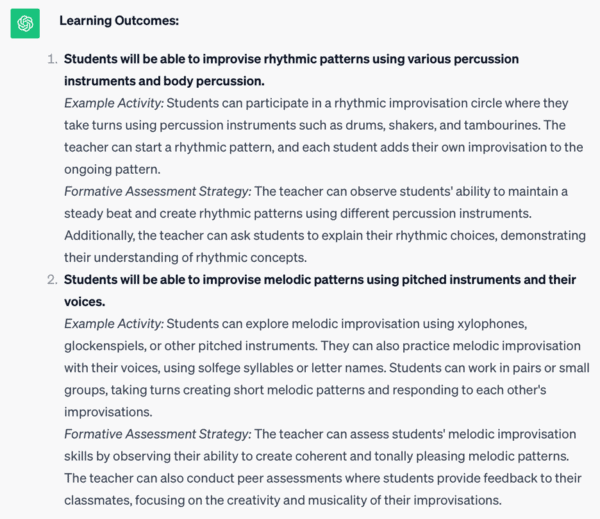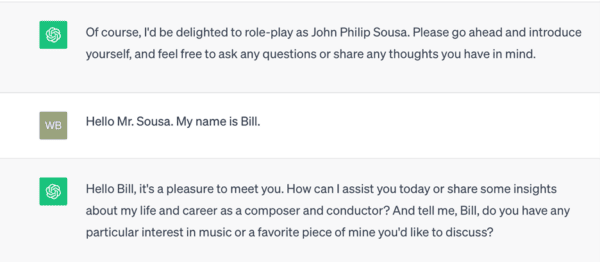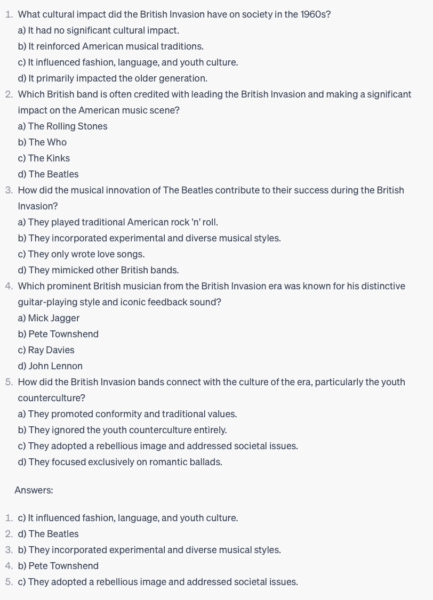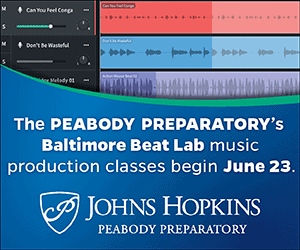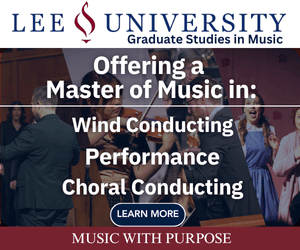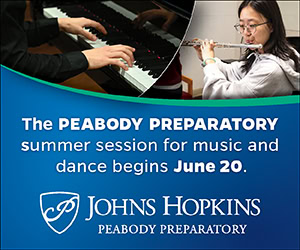/ News Posts / Make AI Your Personal Music Teaching Assistant
Make AI Your Personal Music Teaching Assistant
4 Ideas You Can Use Now!
By William I. Bauer, School of Music, University of Florida
This article was first published on the University of Florida, Online Master of Music in Music Education blog and is sponsored by the University of Florida, Online Master of Music in Music Education.
Today, there is a lot of buzz about artificial intelligence (AI), with both excitement and concern about how it will impact our lives. In particular, the widespread availability of AI built on large language models that are capable of understanding and generating human-like text has resulted in new AI tools that are user-friendly and accessible to everyone.
What impact will this have on music education? Only time will tell, but there are some ways that music teachers can harness this technology now to help with instructional tasks that may be time-consuming or tedious. Teachers can also use AI to brainstorm new ideas and approaches to engaging students in music learning activities. AI has the potential to become your personal music teaching assistant.
In this blog post, I provide four examples of ways music teachers might integrate AI into their workflow by using two free online tools, OpenAI’s ChatGPT and Bing Image Creator. ChatGPT and Bing Image Creator are generative AI (GAI) applications. GAI tools can generate content such as text, images, videos, audio, and other forms of data that resemble human-created content.
A word of caution is in order when examining the content created by a GAI; it is prone to hallucinations. A hallucination in this context is when an AI makes up a plausible but inaccurate response as the truth. This happens because GAI tools generate responses based on patterns in the data they have been provided, without the ability to apply logic or detect factual inconsistencies. Consequently, they might output information that is incorrect or illogical, without realizing the error. Researchers are working to make GAI more reliable.
It’s All about the Prompt!
For an AI to provide assistance, it must receive an inquiry or prompt from the user. Prompts are usually typed into a designated location in the AI, however, recently it was announced that verbal and picture prompts can now be used with the paid version of ChatGPT. This will undoubtedly become a common way to interact with an AI. Importantly, the quality of prompts provided to an AI will impact the type of results received.
In general, you should communicate with an AI in a manner similar to how you might talk to a young child. Be very exact and explicit. AI is literal; don’t assume that it will correctly fill in any gaps you have left. Good prompts are clear and specific, provide essential contextual information, and include relevant keywords. Don’t be afraid to iterate a prompt to get better results: you may need to experiment to receive a suitable response.
You are encouraged to try out the prompts below, varying them as appropriate to fit your situation. Also, try your own prompts. The best way to learn how these tools work is to experiment with them.
Brainstorming Lesson Plans
Lesson plans are important, but they can be time-consuming to write. Teachers may also want to seek inspiration for new approaches and ideas to use. ChatGPT can help. Here is a prompt I gave it to brainstorm ideas for a lesson plan:
Create two student learning outcomes for a second-grade general music class based on the following national music standard: Improvise rhythmic and melodic patterns and musical ideas for a specific purpose. What are some examples of learning activities and formative assessment strategies that align with these learning outcomes?
Within seconds, ChatGPT responded:
If I wasn’t satisfied with this response, I could refine my prompt and try again, or I could take this output and manually adapt it as I saw fit.
Conversing with a Historical Figure
Imagine being able to talk directly to a historical figure in music to learn more about them and their accomplishments. This can be simulated with ChatGPT. Here is a prompt:
I want to know more about John Philip Sousa by role-playing a conversation with him. You will play the role of John Philip Sousa and I will play myself. You should answer questions I pose to Sousa. You should also ask me questions that help to extend our dialog and allow you to learn about me and why I’m interested in you. Use my name when talking to me. We will begin when I introduce myself.
ChatGPT’s response:
Our conversation continued, covering a variety of topics. For instance, I asked “Mr. Sousa” what his primary instrument was. “He” responded:
 Creating an Image as a Response to Music
Creating an Image as a Response to Music
Ask students to create a list of the observations, thoughts, and emotions they experience while listening to a musical composition. Then, enter that list of descriptors into a text-to-image generator to create a visual representation of each student’s response to the musical selection. The class could then share their images with each other and discuss what they heard in the music, as represented in their image.
While listening to Prelude to the Afternoon of a Faun by Claude Debussy, I generated a list of words that came to mind (dreamy, awakening, floating, flute, pentatonic, calm, exploring, meadow, impressionism) and used Bing Image Creator to generate this image:
 Assessment
Assessment
ChatGPT can create various types of assessments (e.g., essay, multiple choice, rubrics). Here is an example of a multiple-choice quiz about the 1960s British Invasion in pop and rock music. First, I created two student learning outcomes, which can be seen in the prompt below. ChatGPT could help create these, if desired. Next, I used ChatGPT to generate an article about the British Invasion for students to read. After having students read the article, I would facilitate a class discussion, which might include watching relevant YouTube videos and listening to music from the era. Finally, I would check students’ understanding of the topic by having them take a brief multiple-choice quiz, generated by ChatGPT using the following prompt:
Generate five multiple-choice questions that cover the main topics of the British Invasion in popular music, including prominent musicians and how the music connected with the culture of the era. These questions should align with the following student learning outcomes: “(1) Students will analyze the cultural impact of the British Invasion on society. (2) Students will critically assess the musical innovation of key British Invasion bands.”
This is the quiz, created by ChatGPT:
If I didn’t like this set of questions, I could click ChatGPTs “regenerate” button as much as I desired, prompting it to create five more questions each time. In the end, I could pick and choose which questions to use among the options provided by ChatGPT.
Final Thoughts
Artificial intelligence, in many forms, will undoubtedly affect our personal and professional lives. As music teachers, we and our students can benefit from the possibilities AI offers. However, it is important that we be part of the wider professional conversation and actively take part in discourse related to appropriate uses, ethical considerations, and pedagogical practices related to AI. Get started by experimenting with tools such as ChatGPT, Bing Image Creator, and AIVA, an AI music composition platform.
About the author:
 William I. Bauer is Professor and Director of the Online Master of Music in Music Education program in the School of Music of the University of Florida. At UF Dr. Bauer teaches undergraduate and graduate-level classes in music education that include technology for music learning, creative thinking in music, psychology of music, music in secondary schools, and music education research and measurement. He has published his research and other writings in leading journals, book chapters, and other publications. Bauer’s book, Music Learning Today: Digital Pedagogy for Creating, Performing, and Responding to Music (2nd ed.), published by Oxford University Press, is used in collegiate music education courses across the U.S. and internationally. Professor Bauer has presented both research and pedagogical sessions in numerous prominent venues throughout the U.S. and abroad and has served on the editorial boards of leading journals such as the Journal of Research in Music Education, Music Educators Journal, and Journal of Music Teacher Education, among others. Currently, he is the editor of the journal Research Perspectives in Music Education and the Research Informed Music Learning (RIML) book series. Dr. Bauer was named an Apple Distinguished Educator by Apple in 2003 and a Google Certified Teacher by Google in 2008. To learn more, visit billbauer.net.
William I. Bauer is Professor and Director of the Online Master of Music in Music Education program in the School of Music of the University of Florida. At UF Dr. Bauer teaches undergraduate and graduate-level classes in music education that include technology for music learning, creative thinking in music, psychology of music, music in secondary schools, and music education research and measurement. He has published his research and other writings in leading journals, book chapters, and other publications. Bauer’s book, Music Learning Today: Digital Pedagogy for Creating, Performing, and Responding to Music (2nd ed.), published by Oxford University Press, is used in collegiate music education courses across the U.S. and internationally. Professor Bauer has presented both research and pedagogical sessions in numerous prominent venues throughout the U.S. and abroad and has served on the editorial boards of leading journals such as the Journal of Research in Music Education, Music Educators Journal, and Journal of Music Teacher Education, among others. Currently, he is the editor of the journal Research Perspectives in Music Education and the Research Informed Music Learning (RIML) book series. Dr. Bauer was named an Apple Distinguished Educator by Apple in 2003 and a Google Certified Teacher by Google in 2008. To learn more, visit billbauer.net.
Did this blog spur new ideas for your music program? Share them on Amplify! Interested in reprinting this article? Please review the reprint guidelines.
The National Association for Music Education (NAfME) provides a number of forums for the sharing of information and opinion, including blogs and postings on our website, articles and columns in our magazines and journals, and postings to our Amplify member portal. Unless specifically noted, the views expressed in these media do not necessarily represent the policy or views of the Association, its officers, or its employees.
Published Date
November 2, 2023
Category
- Technology
Copyright
November 2, 2023. © National Association for Music Education (NAfME.org)

